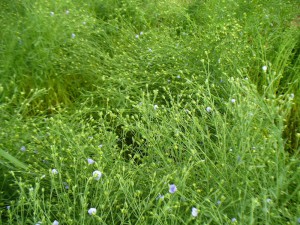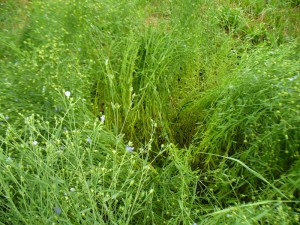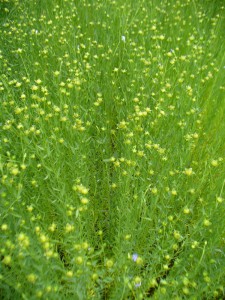I have been hesitating to post this because I don’t have much in the way of photo documentation, plus it’s sad. On Monday (June 25th) we had very heavy rain and thunderstorms. It had been very hot for a few days and I’d been watering the flax and garden each day, so I was glad for the rain. But on Tuesday I arrived at the community garden to a very sad sight. The v.n.s. looked as if someone had parted it with a comb down the middle of the bed, and then combed it flat on either side of the part. Flat. Poor flat flax. I hadn’t brought my camera, so there is no photo of the scene, but maybe you can conjure a mental image. I tried to fluff it up and shake off the excess water and encourage the stalks to stand upright again. They stood up a little, in a wobbly way, but I fear their former graceful and erect stature is gone forever. The Marilyn, which has already suffered from lodging, was also hard-hit. In contrast, the Evelin was not affected, happily.
Later on Tuesday I checked on the plot at Amethyst Farm, and there was a similar scene there.
 The “part” down the middle wasn’t quite as straight in this vns bed, but the effect was the same. Flatness. Here’s how it looked after I tried to fluff it up.
The “part” down the middle wasn’t quite as straight in this vns bed, but the effect was the same. Flatness. Here’s how it looked after I tried to fluff it up.
You can see that the curvature in the stems is still there, and the stalks swirl in little clumps. We had more rain on Tuesday afternoon, which didn’t really help matters. Today it is Friday and the swirly-bendy-ness hasn’t changed.
At Amethyst Farm the Evelin was, once again, unaffected. Here it is on Tuesday looking perfectly happy.
So, perhaps one lesson that can be drawn from this experience is that Evelin is a bit more sturdy when it comes to withstanding heavy wind and rain.
Finally, in the evening on Tuesday I checked the plot at Small Ones Farm and both the Evelin and vns were fine. The plants are much shorter over there for some reason, and more sparse. This makes me think that sowing less heavily and having fewer plants per square foot may have an advantage in that it may provide a crop with greater protection from heavy wind and rain damage. The argument against it is that, in theory, sparser growth makes for coarser, and shorter, fibers due to the fact that the stems can get thick and branch out. I guess there are pros and cons to every approach. Maybe planting more sparsely and harvesting early, to get finer fiber, would be ideal.
On another note, you can see in the photo of the Evelin above that peak bloom has passed and the green seedpods are developing. Peak bloom means that the whole bed has bloomed, and then the plants put energy into setting up seed, and they move into a later stage of their growth cycle. The vns, however, keeps blooming away merrily and shows no signs of slacking off.
Noticing this difference sheds some light on a problem I never really understood before. The first time I grew flax, in 2004, I grew it up at my mother’s place in New Hampshire. I ordered the seed from Richters (which is where I got the vns and Evelin this year, too), but I don’t remember what variety it was. One way to judge when flax is ready to harvest is to wait until 30 days after peak bloom. Well, I kept waiting and I never harvested it because it kept on blooming and blooming. Next thing you know, it snowed. So, perhaps for some varieties, you need to judge the harvest time not by when it flowers but just by the calendar, i.e., between 90 and 100 days after planting.
So many variables, and so much to learn. At this point I plan to harvest it all in about two weeks, around July 15th.



